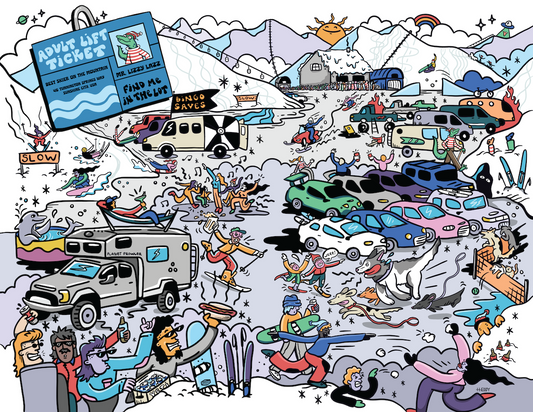
Originally published in the weekly Here & There newsletter by Kyle Frost. Subscribe here.
Short term solutions?
Colorado legislators will consider a bill in 2024 that would quadruple the property taxes of many short term rental (STR) properties, requiring them to pay the same property taxes as hotels. It’s merely the latest development in a series of laws and local regulations that attempt to manage the exponential growth of STRs in mountain towns and tourism-heavy areas while balancing the housing needs of residents and local workforces.
What's in the bill?
Any properties that rent for more than 90 days will be taxed as commercial properties, rather than personal ones. If it becomes law, the bill in question would take effect in 2026 and would boost taxation from 7.15%, as it is scheduled to be under existing law, to 29%.
Many homeowners are concerned that the increase in taxation would render these properties essentially unaffordable, as they rely on STR income to cover or supplement their monthly mortgage payments.
Why is this happening?
Although this is a “Colorado” bill, it’s not an issue that is Colorado specific. It’s not news that mountain towns are in the midst of a housing crisis, exacerbated by relocations during the pandemic, rising housing prices, zoning constraints, and more. Increases in short-term rentals often leaves mountain towns short of housing for both seasonal and permanent residents. There is some evidence that Airbnb increases asking prices for rent by suppressing the supply of rental units offered for rent. A 2019 report found that “the costs of Airbnb expansion to renters and local jurisdictions likely exceed the benefits to travelers and property owners.”

In Breckenridge, 14.5% of renters were forced out due to owners converting the property to an STR (2021 Memorandum).
On the other hand...
Should short term rental owners be taxed the same as a “real” hotel? It's tough to distinguish between "good" locals that are supplementing income in hard to afford areas and "bad" landlords who view STR units as an investment/income stream. Some residents express concern that landlords could take housing off the market altogether instead of converting it to long-term housing, which would do nothing to address the lack of available seasonal housing.
Mountain towns are already taking things into their own hands
Over the last few years, mountain towns across the country have been pioneering a wide range of strategies targeted at minimizing the impact of STRs. In Colorado’s Summit County, the Lease to Locals program “aims to immediately increase the number of long-term rental units available to the County’s workforce by offering financial incentives to homeowners, who can more easily pay their bills & use their unit on the short-term rental market, in exchange for long-term leases.” The towns of Frisco, Breckenridge, and Silverthorne already have some of the toughest STR regulations and fees in the country – Breckenridge charges a $756/year fee per bedroom. South Lake Tahoe implemented new policies phasing out STRs in residential areas beginning in 2018 and Crested Butte significantly limited available permits and added strict zoning regulations beginning in 2017.

Regulation isn't confined to mountain towns. While new laws in New York don’t ban Airbnb outright, they’re so restrictive that it nearly does. Amsterdam puts nightly limits at 30 nights per year, Paris at 120 days. In San Francisco, only full-time residents can host short-term rentals, and for a maximum of 90 days a year. Florence, Italy is moving to ban Airbnb in the city center moving forward.
Does regulation work?
The generally stated goals of STR regulations are to lower nearby rental rates and improve housing supply. But, do they actually accomplish that? The real answer is…no one really knows.
While there’s some evidence that Airbnb reduced rental prices by 3% in Irvine, California, I’ve been able to find very little concrete research indicating that the effect is replicated across different locations. Skift reports that in New York, where STR availability has plummeted, there has been no increase in rental inventory. “Apartment List, which maintains a roster of vacant apartments, found that the vacancy rate in December was 3.2% – the same as in September.”
Geographically and supply constrained mountain towns aren’t going to magically become “affordable”. These are still incredibly desirable places to live and real estate prices are likely to continue to reflect that demand. The 2021 Mountain Migration Report found that “the majority of full-time residents employed locally cannot successfully compete for housing when escalated demand and prices are driven by households earning much higher incomes.”

Ultimately, I'm not sure STR regulation works unless paired with vacancy taxes like South Lake Tahoe is currently proposing. It's hard to improve housing supply and affordability when "44% of all housing units are just sitting vacant for most of the year".
A few possible outcomes in Colorado
New regulations lead to a sell-off of STRs and an increase in available housing supply. An improved equilibrium between housing for local residents and STRs is reached. The most hopeful outcome.
STR availability drops and hotel prices increase, particularly in mountain towns where supply is constrained. When combined with the increasing costs of skiing, this could have a negative impact on tourism visitation – and lots of cascading effects.
Owners that can afford the changes will rent just under the maximum days, but only in the most profitable time of the year (winter), leading to significantly reduced capacities in the summer months.
Newly available supply just gets snapped up by folks who have more than enough money to not care about tax rates, and they’ll just sit empty most of the year (a la South Lake Tahoe, Vail, etc).
Mountain economies are a balancing act
Many of the places most affected by STRs are partially (or heavily) dependent on a tourism economy. There continues to be a challenging balance to strike between availability and affordability for locals and visitors. But, I think there’s a question as to whether these towns are capable of the tourism ‘carrying capacity’ they currently support. While social media and intentional campaigns by regional destination marketing organizations (DMOs) have driven increasingly more visitor spending to mountain economies, at what point is it “too much”? Too many people, too much traffic, too many Airbnbs, etc. Tourism numbers can’t keep going up and to the right every year. Is there room for more, or are we already at max capacity?
Although local businesses and ski resorts would prefer to see numbers go up every year, perhaps more balanced mountain economies with a higher percentage of local residents and lower visitors (due to lower densities of STRs and higher costs) will be better in the long run.
Thanks for stopping by. If you've got comments, feedback, or suggestions for a future newsletter you can reply to this email or get in touch directly at kyle.frost@mountaingazette.com.









